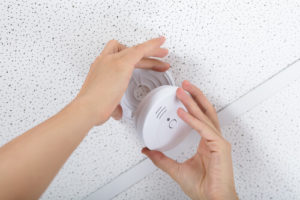It will soon be time to close our windows and doors to falling temperature, then to fire up the furnace and enjoy the glowing warmth of the fireplace. Your carbon monoxide detectors play an important role in keeping you and your family safe during the winter months, when houses are closed up and carbon-monoxide-emitting appliances are in use. This fall, be sure to test your carbon monoxide detectors!
How to test your carbon monoxide detectors
Exactly how you test your carbon monoxide detectors will depend on the brand and model of carbon monoxide detector you have installed in your home. Generally, there is a button you push to make the alarm sound, just like a smoke detector. Regardless of the specifics, you will want to enlist the help of another person in testing your home’s carbon monoxide detectors. If your carbon monoxide detectors are hardwired together, you will want to be near one carbon monoxide detector and have the other person near another to verify that both alarms are sounding at the same time. You also will want to have that person stand in different parts of the house as you test the alarm to make sure that the alarm is audible in all areas of your home. To ensure that everyone in your home will be alerted to the presence of carbon monoxide, a good rule of thumb is to have at least one carbon monoxide detector on every floor of your home and in every sleeping area. They should be installed on or near the ceiling, as carbon monoxide rises.
Maintaining your carbon monoxide detectors
Beyond just checking the alarm on your carbon monoxide detectors, you will want to perform some maintenance to keep your carbon monoxide detectors in working condition all winter. Dust your carbon monoxide detectors to be sure they are free from any dirt or debris that will hinder their ability to take accurate readings. Check the carbon monoxide detector to be sure that nothing has accidentally been applied to the carbon monoxide detector, such as paint, that could interfere with the detector’s function. It’s also wise to check the dates on your carbon monoxide detectors to determine the age of the units. Most carbon monoxide detectors will have manufacture dates on them. Carbon monoxide detectors generally should be replaced every 5 to 7 years.
Educating your family
You should be testing your carbon monoxide detector every six months. When you perform your testing and maintenance, you also should take the time to talk to your family about carbon monoxide. Make sure they know what to do if they alarm sounds: The house should be vacated immediately, and the fire department should be called. Anyone experiencing symptoms of carbon monoxide poisoning should be treated by a medical professional.
Regularly testing an maintaining your carbon monoxide detectors is an important part of keeping your home and family safe from carbon monoxide this winter! Another important part of preventing carbon monoxide buildup in your home is having your vented appliances cleaned and inspected. Your chimney, furnace and clothing dryer vents should all be cleaned and inspected to help prevent carbon monoxide leaks. Call Environmental Chimney Service to schedule your chimney and dryer vent cleaning today!
